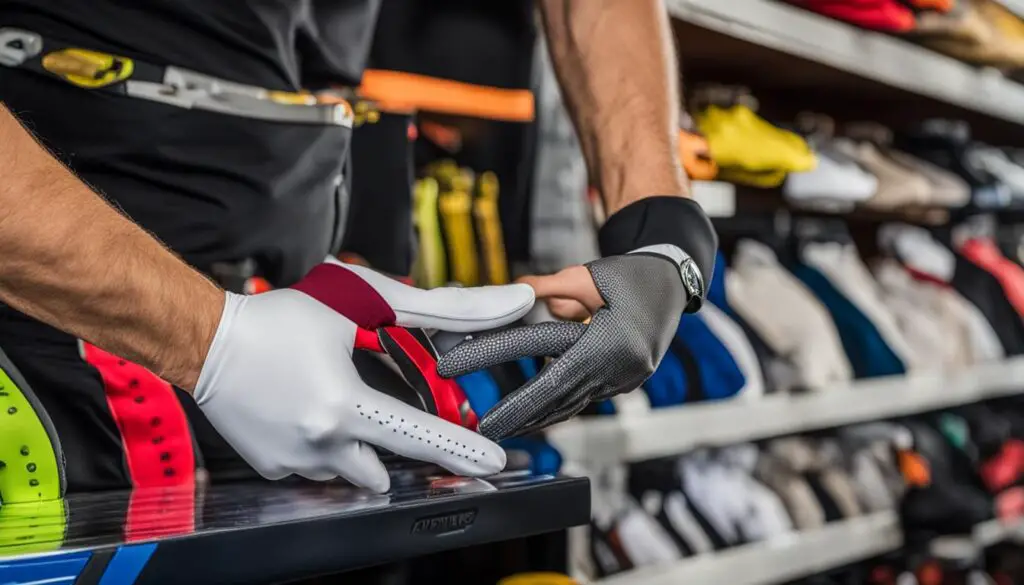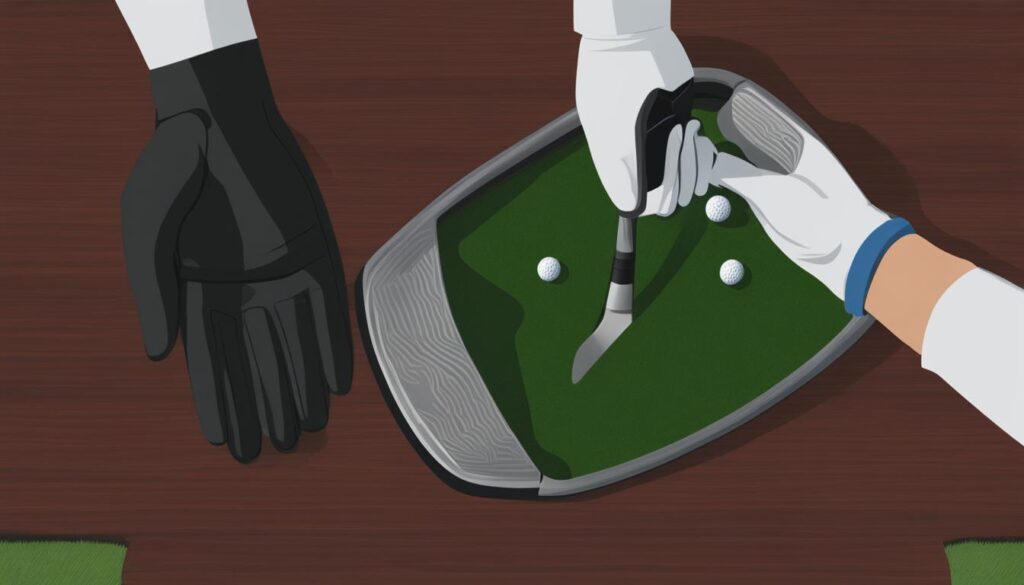Golfers often wear gloves to enhance their grip and control over the club. But which hand should a golfer wear the glove on? The answer lies in understanding the importance of hand positioning in golf.
In golf, the weaker hand, also known as the “lead” hand, is the hand on the top of the grip. For right-handed players, this means wearing a glove on the left hand, while left-handed players wear a glove on their right hand. This positioning allows for a secure grip and optimal control during the swing.
However, it’s important to note that golfers have different preferences. Some choose to wear gloves on both hands, while others prefer not to use gloves at all. Ultimately, the decision comes down to personal preference and what feels most comfortable and effective for each individual’s game.
To get a better understanding of the benefits and considerations of wearing a golf glove, continue reading.
Key Takeaways:
- Golfers typically wear a glove on the weaker hand, also known as the lead hand, which is the hand on the top of the grip.
- Wearing a glove on the lead hand helps maintain a consistent grip, prevents slipping, and enhances control and accuracy.
- The decision to wear gloves on one hand, both hands, or no gloves at all varies among golfers and depends on individual preferences.
- When choosing a golf glove, consider the correct size, fit, material, and weather conditions to enhance grip and overall comfort.
- Experimentation is key to finding the glove setup that works best for your golf game.
Why Wear a Golf Glove on the Lead Hand?
Wearing a golf glove on the lead hand, which is the hand at the top of the grip, offers several advantages. Firstly, it helps maintain a consistent grip and prevents the club from slipping or moving during the swing, which can result in a loss of control and accuracy. Additionally, the glove acts as a barrier between the hand and the club, reducing friction and minimizing the risk of blisters and callouses. The glove also provides some warmth on cooler days, making it more comfortable to play in lower temperatures. Ultimately, wearing a glove on the lead hand helps golfers achieve a better overall grip and feel of the club, leading to improved performance on the course.
Choosing the Right Golf Glove
When it comes to selecting a golf glove, finding the right size and fit is crucial for optimal performance on the course. The golf glove should fit snugly but not be too tight, allowing for comfort and flexibility during your swing. As a general rule, about ¼ inch of the Velcro closure should be showing, providing room for adjustments as the glove stretches over time.
Most golf gloves are made from cabretta leather, a premium material that offers excellent grip, a comfortable feel, and decent durability. The soft and supple texture of cabretta leather allows for better sensitivity and control over the club.
When choosing a golf glove, it’s also important to consider the weather conditions you’ll be playing in. Different gloves are designed to perform optimally in specific climates, allowing you to maintain a secure grip in various conditions.
Rain Gloves for Wet Conditions
In wet or rainy conditions, rain gloves are the ideal choice. These gloves are specifically designed to provide a secure grip even when the clubs and your hands are wet. Rain gloves often come in pairs, allowing for quick drying and ensuring you can maintain control of the club throughout your round.
Winter Gloves for Cold Weather
In colder weather, winter gloves are essential for keeping your hands warm and comfortable. However, winter gloves may offer less feel and sensitivity compared to regular golf gloves due to their thicker and insulating materials. It’s important to strike a balance between warmth and maintaining a good grip on the club.
By finding the right glove that suits your hand position and weather conditions, you can significantly enhance your golfing experience. A glove that fits properly and provides the necessary grip and comfort will help you perform at your best on the course.
| Glove Type | Material | Grip Performance | Durability | Weather Suitability |
|---|---|---|---|---|
| Rain Gloves | Synthetic Materials | Excellent, even in wet conditions | Decent | Specifically designed for wet conditions |
| Winter Gloves | Insulating Materials (e.g., thermal fabrics) | Good, but may sacrifice feel | Decent | Provides warmth in cold weather |
| Regular Golf Gloves | Cabretta Leather | Excellent | Decent | Generally suitable for most weather conditions |

Pros and Cons of Wearing a Golf Glove on Both Hands
While most golfers choose to wear a glove on the lead hand only, some players opt to wear a glove on both hands. Wearing gloves on both hands can provide a consistent grip and enhance stability throughout the swing. It can be particularly beneficial for players who struggle with grip strength or hand coordination. However, wearing gloves on both hands may reduce the tactile feel and sensitivity of the grip, which can affect shot control and finesse. It’s important for golfers to experiment and find what works best for their game, whether it’s wearing one glove, two gloves, or no gloves at all.
| Pros of Wearing a Golf Glove on Both Hands | Cons of Wearing a Golf Glove on Both Hands |
|---|---|
| Enhanced grip on both hands | Potential loss of tactile feel and sensitivity |
| Improved stability during the swing | Reduced shot control and finesse |
| Beneficial for players with grip strength or coordination issues |
Ultimately, the decision to wear a golf glove on both hands depends on personal preference and individual playing style. Golfers should consider their grip needs, shot control, and overall comfort when deciding whether to wear one or two gloves. It’s always recommended to try different combinations and find the glove setup that works best for optimal performance on the course.

Conclusion
In conclusion, it is widely accepted in the golfing community that wearing a golf glove on the non-dominant hand, also known as the lead hand, is the preferred practice. This hand is located at the top of the grip and closest to the body. By wearing a glove on the lead hand, golfers can maintain a secure grip on the club and improve their control and accuracy. Additionally, the glove acts as a protective barrier, preventing discomfort and potential friction-related issues.
However, the decision of whether to wear gloves on one or both hands ultimately comes down to personal preference. Every golfer has their unique hand positioning and requirements. Some players may find that wearing gloves on both hands improves their grip strength and stability during the swing, while others may feel that it reduces their sensitivity and finesse. It is crucial for golfers to experiment and find the glove setup that feels most comfortable and effective for their game.
In conclusion, finding the perfect balance between grip, feel, and comfort is key. Whether you choose to wear a glove on just your lead hand or both hands, it is essential to consider factors such as personal preference, weather conditions, hand positioning, and overall game strategy. By exploring different options and taking the time to find the right fit, you can optimize your golfing experience and improve your performance on the course.
FAQ
What hand do golfers wear their glove on?
Golfers typically wear a glove on their non-dominant hand, also known as the lead hand. For right-handed players, this means wearing a glove on the left hand, and vice versa for left-handed players.
Why wear a golf glove on the lead hand?
Wearing a golf glove on the lead hand helps maintain a secure grip and enhances control and accuracy. It also prevents the club from slipping or moving during the swing and reduces friction-related discomfort.
How do I choose the right golf glove?
When selecting a golf glove, it’s important to choose the correct size and fit. The glove should be snug but not too tight, with about ¼ inch of the Velcro closure showing for adjustments as the glove stretches over time. Consider weather conditions and choose appropriate gloves, such as rain gloves for wet conditions and winter gloves for colder weather.
What are the pros and cons of wearing a golf glove on both hands?
Wearing gloves on both hands can provide a consistent grip and enhance stability throughout the swing, which is beneficial for players who struggle with grip strength or hand coordination. However, wearing gloves on both hands may reduce the tactile feel and sensitivity of the grip, affecting shot control and finesse.
Can I choose not to wear a golf glove?
Yes, some golfers choose not to wear gloves at all. The decision to wear gloves, whether on one or both hands, ultimately comes down to personal preference and what feels most comfortable and effective for each golfer.
